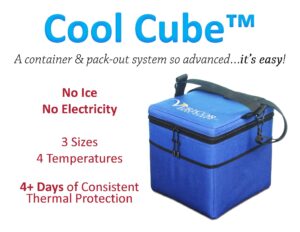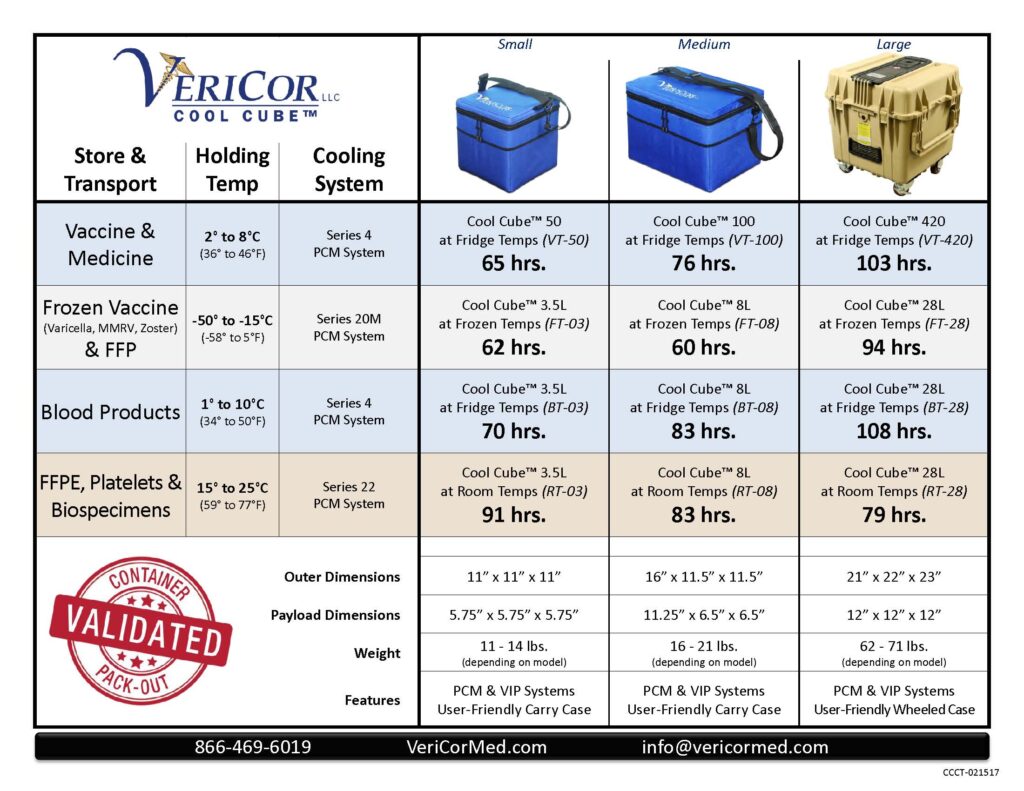 Cool Cube™ PCM Unmasked – An explanation of VeriCor’s “No Ice” statement.
Cool Cube™ PCM Unmasked – An explanation of VeriCor’s “No Ice” statement.
You may not know what PCM stands for, but you are familiar with it.
PCM stands for “phase change material.” The most common PCM we all encounter on a daily basis is water (yes, water is a PCM). At 0°C/32°F, water changes from one phase to another (liquid to solid; solid to liquid).
PCMs are helpful in decreasing, increasing, or maintaining the temperature of something else. For instance water, in its frozen form known as ice, can cool down a soda. On the flip side, in its liquid form water can de-thaw a frozen pipe. The “magic” is the amount of energy it takes to make water move from one phase to another. The energy needed to turn water at 1°C into ice at 0°C is much greater than the amount of energy needed to turn water up from 1°C to 2°C. Therefore ice at 0°C is much more effective at cooling than water at 1°C. For more on the science of PCMs, keyword “pcm phase change material” and get into a comfortable reading position.
At VeriCor, our focus is on using PCM as a passive, maintenance-free way to maintain a specific temperature. Relying on corded, heavy, bulky electrical units is not an option for our customers who need to keep and carry fresh vaccine, frozen varicella or blood platelets at their appropriate temperature in a mobile, portable solution. And since the majority of our customers already use PCM (frozen water bottles) per CDC guidelines, we wanted to improve the process for all temperatures. Why? (good question)
(Moving forward we will be focusing specifically on a desired 2° to 8°C refrigerated temperature, although the same principles apply to any temperature range.)
Even with the little knowledge you may have gathered about PCMs already, a frozen water bottle that is “properly conditioned” should raise some questions. Wouldn’t a frozen water bottle be below the recommended 2°C? Wouldn’t it be at 0°C until it transitions to all water? And once fully transitioned to water, the bottles may pass through the 2° to 8°C range, but not for very long.
Now the question is: what PCM is best? There is actually much more to the obvious answer of “one that has a phase change temperature right in the middle of the desired range” than you might think. (Remember, a phase changing tipping point above or below the desired temperature range could warm or cool product too much.)
The research and development of PCM has been ongoing for years. Companies produce all kinds of PCM: organic and inorganic; toxic and nontoxic; stable and imbalanced; flammable and flameproof; with tipping points from -40°C to 85°C and everything in-between. The most exciting developments are those in which companies are looking to envelop buildings with room temperature PCM (too change states at 22°C/72°F). Imagine that during cool nights the PCM walls are warming the interior, and during hot days the PCM is cooling the interior. It has been proven thermally effective, just not cost effective…yet. But I digressed.
Most PCMs today are chemical formulations derived from petroleum products, waters or salts. Such PCMs have limited temperature variations, containment practices and thermal cycles. Cool Cube™ PCMs are proven superior by those measures and more, including stability, flammability, toxicity and sustainable performance. Each production lot undergoes more than 10 separate quantitative and qualitative tests, including DSC (differential scanning calorimetry), to guarantee quality.
Cool Cubes™ PCMs are made from natural sources (palm oil, palm kernel oil, rapeseed oil, coconut oil, soybean oil, etc.) and are nontoxic and biodegradable (buried in landfills it will naturally degrade in about 6 months). These fully hydrogenated compounds will not oxidize or become rancid. Unlike petroleum-based PCM, they have a low flammability rating.
The safety, data and specifications are important, yet all of that will never be superior to water. But remember, where engineered PCM is superior to water is the specific phase change point. Water has a 0°C/32°F tipping point which is not useful when trying to control an exact temperature other than 0°C/32°F. In danger of being too repetitive, to keep product at a specific temperature, add mass (at that specific temperature) to it. If you add something cooler, your product will get cooler. If you add something warmer, your product will get warmer.
Cool Cubes™ utilize three different PCMs: Refrigerated, Frozen & Room Temps
The Refrigerated Variation
Phase Change Point: 4.5°C/40.1°F
Rationale: VeriCor customers buy these Cool Cube™ variations to prevent both cooling (up in Canada when the coolers are sitting out on the frozen tarmac waiting for a plane to take them to a remote village) and warming (down in Haiti where the coolers are exposed to the hot sun during transit), so 5°C would be the obvious pick. However, more of our customers are preventing warming, so we wanted to be just a bit cooler without compromising the versatility…thus the 4.5°C tipping point.
Applications: Fresh vaccine, medicine, blood products
The Frozen Variation
The Room Temperature Variation
Want more information on Cool Cube™ PCMs? Just ask us.



You must be logged in to post a comment.